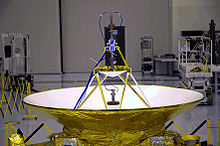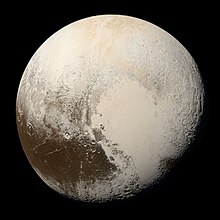Exploration of dwarf planets

The exploration of dwarf planets involves studying these celestial bodies within the Solar System. Since Pluto's reclassification as a dwarf planet in 2006 by the International Astronomical Union (IAU), space exploration has increasingly focused on these celestial bodies.
In 2015 significant milestones in dwarf planet exploration were reached with the flybys of Pluto and Ceres by the New Horizons and Dawn spacecraft.[1][2]
Technical requirements[edit]
Exploring dwarf planets demands significant fuel resources, which vary depending on the targeted celestial bodies.[3] However, various methods have been developed to conserve fuel in probes traveling long distances.

Missions to dwarf planets in the outer Solar System necessitate careful planning and execution, with spacecraft hibernation employed specifically to conserve energy for the prolonged interplanetary journeys. This allows the spacecraft to endure the extended travel time while maintaining essential functions for navigation and communication.[4][5]
Successful missions to distant dwarf planets also require substantial fuel reserves on board. These reserves are crucial for trajectory adjustments, course corrections, and orbital insertions upon arrival at the target dwarf planet. The spacecraft's propulsion systems must deliver the necessary thrust over long distances to counter the gravitational influences of celestial bodies encountered during the journey.
Gravity assists are critical for optimizing spacecraft trajectories and accelerating them toward their target dwarf planets. During a gravity assist, the spacecraft uses the gravitational pull of celestial bodies, such as planets or moons, to gain momentum and alter its trajectory without expending extra fuel. Careful planning of these maneuvers can significantly reduce travel time and fuel requirements for reaching distant dwarf planets.[6]
Furthermore, high-gain antennas are pivotal in space exploration, especially in missions to distant celestial bodies like dwarf planets. They ensure dependable communication between spacecraft and Earth across vast interplanetary expanses. Unlike conventional antennas, high-gain antennas concentrate their radiation pattern into a narrow beam, enhancing signal strength and data transmission rates. This feature is vital for maintaining uninterrupted contact with spacecraft operating in the remote reaches of the Solar System, where radio signals undergo significant attenuation. By leveraging high-gain antennas, mission controllers can receive crucial scientific data and telemetry from spacecraft exploring dwarf planets, enabling real-time monitoring and operational control. Furthermore, these antennas facilitate the exchange of commands and instructions, empowering spacecraft to execute intricate maneuvers and scientific observations autonomously.[7]
Flyby missions[edit]
2010s[edit]
Dawn program (2015)[edit]

In September 2007, the Dawn spacecraft embarked on a mission from Cape Canaveral Space Launch Complex 17[8] on a mission to explore two of the three largest bodies in the asteroid belt, 4 Vesta and 1 Ceres. After nearly four years, Dawn entered orbit around Vesta on July 16, 2011. Subsequently, on September 5, 2012, it concluded its Vesta mission and commenced its journey to Ceres.[2]
On December 1, 2014, Dawn captured images revealing an extended disc around Ceres. Subsequently, in January 2015, it compiled a series of images of Ceres into a stop-motion animation, depicting its rotation, albeit in low resolution. Following January 26, 2015, Dawn obtained higher-quality images than those captured by ground telescopes and the Hubble Space Telescope.[9] Finally, it entered orbit around Ceres on March 6, 2015.[2]
On October 31, 2018, Dawn exhausted its fuel reserves and lost communication with Earth. Consequently, the spacecraft will remain in orbit around Ceres until at least 2038.[2]
New Horizons program (2015)[edit]

In 2006, the New Horizons probe embarked on its mission to explore the Plutonian system.
In 2007, New Horizons performed a gravity assist maneuver using Jupiter. This slingshot increased the probe's velocity by 4 km/s (14,000 km/h; 9,000 mph), cutting its travel time to Pluto by three years.[3]
On February 4, 2015, New Horizons entered the Pluto system, capturing images of Pluto and its moon Charon from about 203,000,000 km (126,000,000 mi) away. From April to June 2015, New Horizons delivered higher-quality images than those from ground telescopes and the Hubble Space Telescope.[10][11]
On July 14, 2015, the New Horizons probe took close-up photos of Pluto from 18,000 kilometers away. The data collected was transmitted back to Earth and received on September 13, 2015.[12][13]
2040s[edit]
IHP-1 (2040)[edit]
IHP-1 is a proposed spacecraft in the Shensuo program, designed to fly by Jupiter, the dwarf planet 50000 Quaoar, and its moon Weywot, before heading into interstellar space.[14]
IHP-1 is set to launch with IHP-2 and the proposed IHP-3.[15] Scheduled for a May 2024 launch, IHP-1 will use gravity assists from Earth in October 2025 and December 2027. It will then fly by Jupiter in March 2029, heading towards the heliosphere's nose. On its way to interstellar space, it will encounter 50000 Quaoar and its moon Weywot in 2040.[15]
Proposed probes[edit]
| Spacecraft | Organization | Proposed launch | Type | Notes | Image | Ref(s). |
|---|---|---|---|---|---|---|
| Fusion-Enabled Pluto Orbiter and Lander | N/A | Orbiter/Lander | A probe equipped with a Direct Fusion Drive (DFD) propulsion system that is planned to orbit and land on Pluto. |  |
[16] | |
| Pluto Hop, Skip, and Jump | N/A | Lander | A probe designed to land on Pluto, drawing parallels to the proposed Triton Hopper mission. | N/A | [17] | |
| Persephone | N/A | Orbiter | A probe that will orbit Pluto for three years and investigate the possibility of a subsurface ocean, if present. | N/A | [18] |
Human exploration[edit]
The concept of human exploration of dwarf planets has intrigued scientists since Pluto's discovery in 1930. Despite the vast distances and significant challenges, advancements in space technology could make such endeavors possible. Colonizing dwarf planets offers potential economic benefits due to the presence of rare and valuable ores.[19]
Potential for colonization[edit]
This article's tone or style may not reflect the encyclopedic tone used on Wikipedia. (June 2024) |

Once deemed science fiction, the colonization of dwarf planets is now becoming increasingly plausible. Solar sails, capable of transporting heavy loads, offer the potential to ferry humans to these distant bodies.[20] Furthermore, the development of cryogenic sleep could facilitate long-duration journeys to dwarf planets.[21]
To enable human colonization, structures must be constructed from durable materials capable of withstanding extremely cold temperatures. In the harsh environments of dwarf planets, materials may become brittle and contract, posing significant structural risks.[22][better source needed] Moreover, the absence of a strong magnetosphere and magnetic field exacerbates the structural risks faced by building materials on dwarf planets. Without the protective shield provided by a robust magnetosphere, these celestial bodies are more susceptible to cosmic radiation and solar wind. Prolonged exposure to such radiation can degrade building materials over time, compromising their structural integrity. Thus, innovative engineering solutions must address not only temperature fluctuations and material brittleness but also provide adequate protection against radiation-induced deterioration to ensure the long-term viability of structures on dwarf planets.[23][better source needed]
Mining operations on dwarf planets present significant economic opportunities. Many outer dwarf planets boast surfaces abundant in nitrogen ice, which, although not intrinsically valuable, could be crucial for space colonization.[24][better source needed] Additionally, these bodies may harbor rare elements and minerals, including hydrocarbons and precious metals like platinum. Extracting these resources has the potential to bolster technological advancements and spur economic prosperity on Earth.
References[edit]
- ^ Howell, Elizabeth (20 October 2021). "New Horizons: Exploring Pluto and Beyond". Space.com. Retrieved 27 May 2024.
- ^ a b c d Wall, Mike (1 November 2018). "Dawn Is Dead: NASA's Pioneering Asteroid-Belt Mission Runs Out of Fuel". Space.com. Retrieved 27 May 2024.
- ^ a b "Pluto-Bound New Horizons Spacecraft Gets a Boost from Jupiter". Johns Hopkins APL. February 28, 2007. Archived from the original on November 13, 2014. Retrieved 27 May 2024.
- ^ Bowman, Alice (25 April 2010). "Spacecraft Hibernation: Concept vs. Reality, A Mission Operations Manager's Perspective". Space Ops 2010 Conference. AIAA SpaceOps 2010 Conference. doi:10.2514/6.2010-2161. ISBN 978-1-62410-164-9.
- ^ West, John L.; Accomazzo, Andrea; Chmielewski, Arthur B.; Ferri, Paolo (28 June 2018). Space mission hibernation mode design: Lessons learned from Rosetta and other pathfinding missions using hibernation. 2018 IEEE Aerospace Conference. doi:10.1109/AERO.2018.8396812.
- ^ Shortt, David (27 September 2013). "Gravity assist". The Planetary Society. Retrieved 28 May 2024.
- ^ Zainah Md Zain; Hamzah Ahmad; Dwi Pebrianti; Mahfuzah Mustafa; Nor Rul Hasma Abdullah; Rosdiyana Samad; Maziyah Mat Noh (2020). Proceedings of the 11th National Technical Seminar on Unmanned System Technology 2019: NUSYS'19. Springer Nature. p. 535. ISBN 978-981-15-5281-6. Extract of page 535
- ^ "Expendable Launch Vehicle Status Report". NASA. May 11, 2007. Archived from the original on June 23, 2017. Retrieved November 9, 2013.
- ^ "Dawn Journal October 31". NASA. October 31, 2014. Archived from the original on January 20, 2015. Retrieved January 18, 2015.
- ^ NASA (2015). "Timeline". New Horizons News Center, Johns Hopkins Applied Physics Laboratory. Retrieved 14 July 2015.
- ^ Morring Jr., Frank (29 April 2015). "New Horizons Delivering Pluto Imagery With Better Resolution Than Hubble". aviationweek.com. Retrieved 14 July 2015.
- ^ "Sunset on Pluto [Slide Show]". Scientific American. Retrieved 2015-09-17.
- ^ "Pluto 'Wows' in Spectacular New Backlit Panorama". 17 September 2015. Archived from the original on 17 September 2015. Retrieved 2015-09-18.
- ^ Jones, Andrew (16 April 2021). "China to launch a pair of spacecraft towards the edge of the solar system". SpaceNews. SpaceNews. Retrieved 29 April 2021.
- ^ a b Wu, Weiren; Yu, Dengyun; Huang, Jiangchuan; Zong, Qiugang; Wang, Chi; Yu, Guobin; He, Rongwei; Wang, Qian; Kang, Yan; Meng, Linzhi; Wu, Ke; He, Jiansen; Li, Hui (2019-01-09). "Exploring the solar system boundary". Scientia Sinica Informationis. 49 (1): 1. doi:10.1360/N112018-00273. ISSN 2095-9486. S2CID 86476811.
- ^ The next Pluto mission—an orbiter and lander?. Nancy Atkinson, PhysOrg. 27 April 2017.
- ^ "Global Aerospace Corporation to present Pluto lander concept to NASA". EurekAlert!. Retrieved 2018-07-08.
- ^ "New videos simulate Pluto and Charon flyby; return mission to Pluto proposed". August 2021. Archived from the original on 4 September 2021. Retrieved 4 September 2021.
- ^ Benningfield, Damond (27 March 2024). "Dwarf Planets Show Evidence of Recent Geologic Activity". Eos. Retrieved 27 May 2024.
- ^ "What is solar sailing?". The Planetary Society. Retrieved 27 May 2024.
- ^ Russell, Jimi (11 January 2024). "Brr, It's Cold in Here! NASA's Cryo Efforts Beyond the Atmosphere". NASA.gov. Retrieved 27 May 2024.
- ^ Liu, Zi-Kui; Shang, Shun-Li; Wang, Yi (14 April 2017). "Fundamentals of Thermal Expansion and Thermal Contraction". PubMed Central. Retrieved 27 May 2024.
- ^ "Agent of Deterioration: Light, Ultraviolet and Infrared". Canada.ca. Retrieved 29 May 2024.
- ^ Salerno, Louis J.; Gaby, J.; Johnson, R.; Kittel, Peter; Marquardt, Eric D. (2002). "Terrestrial Applications of Zero-Boil-Off Cryogen Storage". In Ross, R. G. (ed.). Cryocoolers 11. Kluwer Academic Publishers. p. 810. doi:10.1007/0-306-47112-4_98. ISBN 978-0-306-46567-3.
